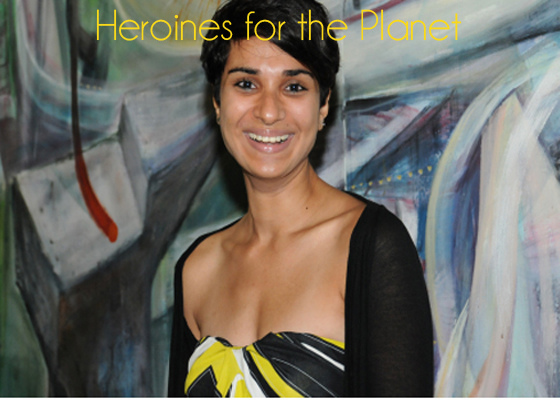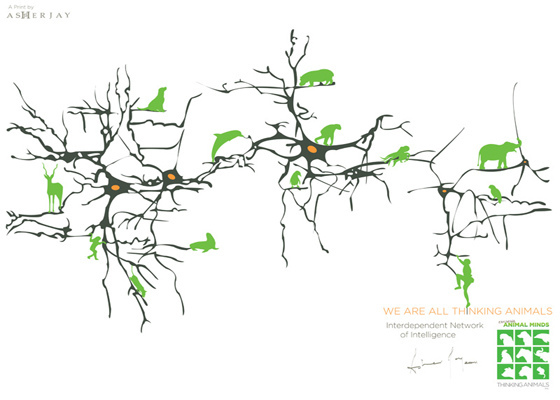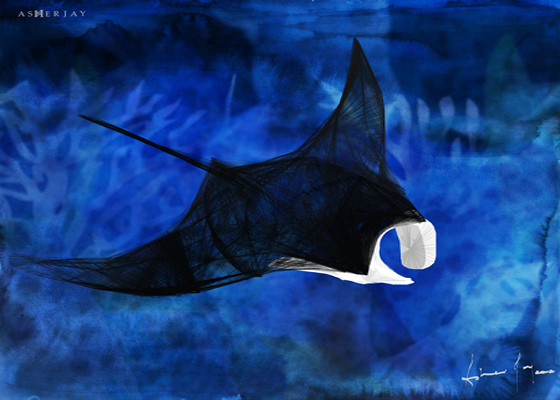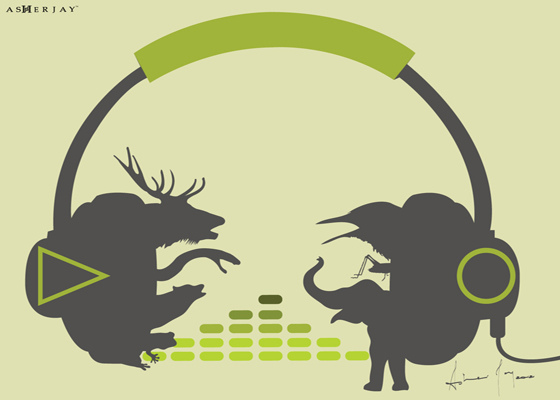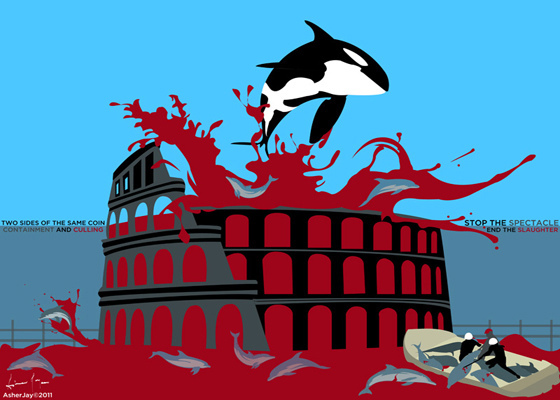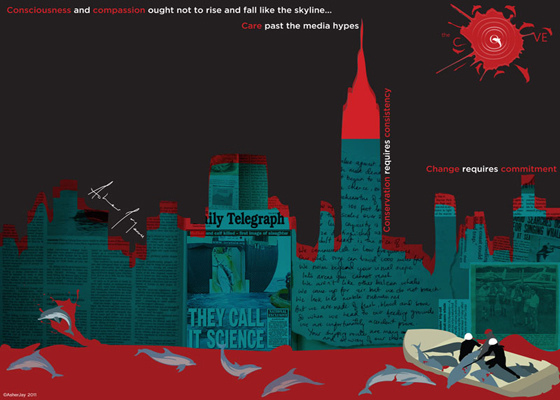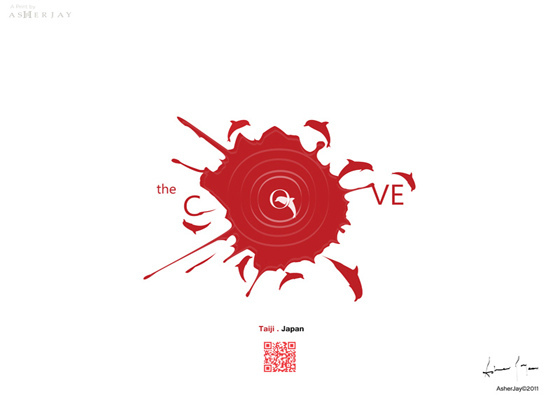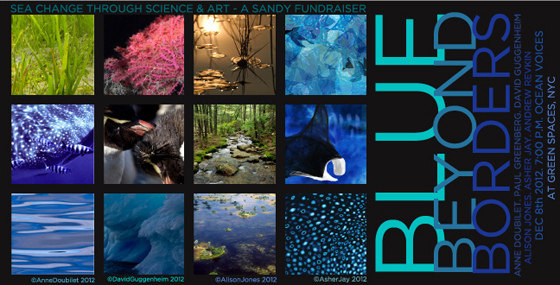
Heroines for the Planet: Art Activist Asher Jay
It’s Asher Jay’s indomitable spirit — an appreciation and understanding that everything in this beautiful life is interconnected — that is ever present in her work as an art activist and fashion designer. Each of her pieces has a bold message, packaged in such a way that’s both relatable and educational.
The heroine opened up to Eco Chick about her creative process, the deep passions that drive her, and her work with Ric O’Barry’s campaign to end the dolphin slaughter in Japan.
Lindsay: What sparked your interest in animal rights, wildlife conservation, and sustainable development?
Asher: Animals are sentient, emotional, loving beings who connect to the earth and the present tense profoundly and effortlessly. They can see in spectrums of light we cannot, hear in frequencies we fail to pick up on, and communicate using more field data than we can avail ourselves of sans expensive instrumentation. I was raised with animals for siblings, as equals. Animal rights have always been an implicit part of my experience and vocabulary as an artist, a woman, and a human being, and this ubiquitous awareness ultimately led to my becoming an activist. The way I see it, we humans are animals, and we seem to think we deserve certain inalienable “rights.” However, by not extending these “rights” or “freedoms” to other life forms that cohabit this planet with us as living markers of our own evolutionary and biological development, we ultimately deny ourselves the full potential of these rights. By denying the parts of us that thrive outside our physical form as wild biodiversity, we are failing to acknowledge our own lineage and story.
The story of being human includes the story of the universe, the earth, the single-celled life forms that burgeoned in the primordial soup, the dinosaurs, the mass extinctions, all the way to the dwindling count of rhinos, tigers and tuna in the present day. We are all-encompassing, for within us we hold all the problems, all the solutions and all of life, we are not separate from any of it, and every time we destroy something we deem discrete from us, we kill a part of ourselves. I have always wondered why I hurt to a paralyzing degree when I read about by-catch, incidents of poaching, or mass strandings; it is because a part of me dies with each of those losses, and selfishly I mourn for me. We need to want to live, and live well, which means all that existed and evolved to deliver us to our upright stance needs to survive, because we really are that immense. For instance, when we speak of conserving whale populations, what is implied is the conservation of every life form that defines a whale’s lifecycle and habitat. Similarly, human beings are so much bigger than they are aware of, our life cycles overlap with every single organism on this planet, which is why our impact radius is so pronounced; it is why we can cause large scale catastrophes and build the majestic pyramids. This is why wildlife conservation and sustainable development matters to me; by conserving them I preserve myself, by ensuring we develop in ways that include the collective I nourish my whole self. I always zoom out to include everything before I zoom in on a specific subject or issue. In the end, we are all versatile, and capable of accomplishing astonishing feats, but none of that will matter if we do not know how inclusive we can be. If we need science, religious texts, and/or pie charts to educate us in the ways of coexistence, then we are not as intelligent as we pride ourselves to be. Life matters and should be treated with respect, compassion, and gratitude. We are LIFE.
Lindsay: How do these passions influence your work as a fashion designer and artist?
Asher: These passions imbue me with the motivation and inspiration to produce succinct, relatable artworks and fashions that are rich in educational content yet capture the imagination of adults and children alike. Nature is rich in magic, color, texture, complexity and awareness; so every one of my creations incorporates all these dynamic elements. To me, art and fashion are inextricably linked; I utilize both to transmit the narrative scope of a singular thought process. This makes it easier for people to recognize and attribute my end products to me, as they all have a distinct vibrant aesthetic sensibility, one that employs raised surface techniques and collages composed of surplus and scraps.
Lindsay: Please describe your work in three words.
Asher: Convergent. Political. Concise.
Lindsay: Do you believe visual imagery is a more relatable and powerful way to promote conservation than words, science or stats?
Asher: Science, words, and stats are important, they are the building blocks of conservation, and they help us understand and relate to the world around us. However, visual imagery is the story, which allows for inter and intra-generational information transference. Visual imagery is the oldest form of communication; it’s democratic and universal. It has both advanced our collective interests and instilled us with fear and distrust. Like anything else, it is but a tool and how we use it brands it with the kind of power it wields on its viewers. Ultimately everybody connects to a well told story, and a comprehensible, articulate picture offers a story in a glimpse. A truly remarkable image can contain multiple narratives within its composition, which can make it unbelievably influential. When people ask me what I do, I always say I create visual PR for the earth and all its inhabitants. To second Louie Psihoyos’ position, visual masterpieces – as stills, animations, or motion pictures – are weapons of mass construction; they can invoke change and seed a movement.
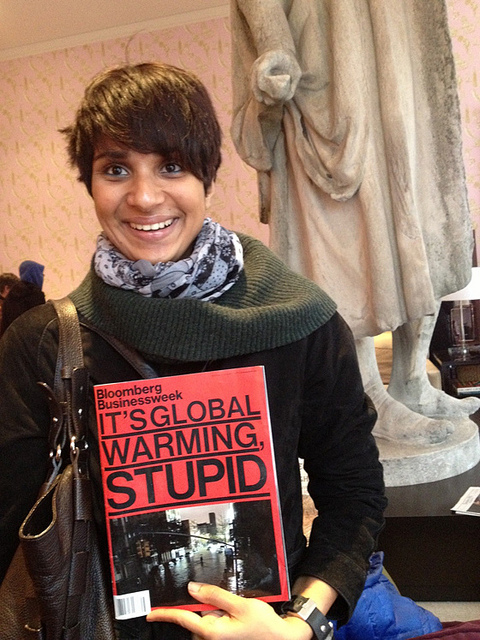
Photo of Asher Jay by Anne Doubilet at Discovering Columbus.
Lindsay: You’ve produced several campaigns now that realistically portray the fragility of the earth in myriad ways. What’s your creative process? Do you extensively research and become really immersed in a cause first?
Asher: All my friends on Facebook and Twitter constantly stream news clips, videos, photographs, petitions and articles; early on I would have to take the initiative, go on a witch-hunt for information, now it’s constantly sent to my inbox. All my people (friends, family, acquaintances, colleagues, dates and roommates) are involved, I rope them in and my constant use of social media as a PSA platform has infected my friends list with a conscience, everyone sends me updates, asks me questions, and requests me to share information with my network. This invariably forms the backbone of my creative process, certain issues get said and resaid in many ways and I begin paying attention to the packaging the content is relayed in. If I feel like I can contour or present the data, issue or suggested solution in a more engaging manner then I illustrate something, if not I just share it with a description of why that link is important for people to visit. I create only when there is a need for more, if what we have is enough then I use my other skills, I write, I speak, I conduct workshops, I petition and protest. I am organic in more ways than just my diet, I am a lateral, conceptual thinker and sometimes a word or a quick chat at a party by the bar can lead to the next installation, painting or Prêt-à-Porter collection. I have begun sketching a work now, about the disconnect between the natural world and artifice, which was inspired by a sit down with Vance Martin from the Wild Foundation at COCO’s Making Waves Celebration Dinner, the initial thumbnail for this piece is on a food stained napkin. Another piece I feel absolutely keen on fleshing out deliberates the insane decline of shark populations in the world’s oceans, due to finning, Japanese use of sharks in fertilizer, by-catch and cartilage pills. I had a conversation with Shawn Heinrichs after I was moved by his footage and talk on the slaughter of these apex predators, and this topic is presently holding my brain hostage, it won’t give me back to myself till I churn out this work. Does that make sense? Sometimes I speak artist and that usually needs subtitles.
Lindsay: Yes it does. So I understand you’re quite the traveler! Please share a particular trip or moment traveling that profoundly impacted you.
Asher: I am not a morning person, but almost every memorable moment with nature has involved an insanely early wakeup call – be it to witness Everest during sunrise or scouting for mass migrations from a hot air balloon over the Serengeti. On one such A.M. expedition, when even the worms knew better than to be up, my mom dragged me to a dock. I don’t recall where this was or why we wanted to do this, but I know it involved a boat, and my seven-year-old butt having to be on it. I was the last to board, and I took a steady step forward only to end up right leg first in the cold lake. My system had miscalculated the distance between the boat and the pier. That was the moment when I truly woke up to both the day ahead and my life at large. I initially flailed about but I quickly realized that if life was going to land me in a lake at 4 a.m., then I may as well luxuriate in the sensations offered by that particular temperature of water at that ludicrous time of day. I have fortunately been given countless opportunities to interact with nature from kayaking in bioluminescent bays to swimming with barracudas. Honestly, traveling is the only education I have ever assimilated without effort, for it offers lessons and insights every step of the way. I am so grateful for the experiences I have logged, as they are so custom-tailored by the unity of time, place and action that once they happen, they can never be replicated. Exploring the unknown and unfamiliar teaches you more about yourself than any institution or instructor can.
Lindsay: How did you get involved in Ric O Barry’s campaign to end the dolphin slaughter in Japan? (We’ve interviewed Leilani Munter for Heroines for the Planet, too!) Can you talk to us about the artworks you created for that particular campaign and why it’s a cause worth fighting for?
Asher: Louie Psihoyos introduced me to Ric O’Barry when they came to New York with Leilani Munter to light up the Empire State Building with red floodlights in Dec. 2011, in honor of the dolphins culled and captured in the cliff veiled ocean inlet in Taiji, Japan, The Cove. This inspired the artwork, “A State of Cove Red,” which integrates news clippings on whaling, strandings, the Faroes Grind and articles on the infamous cove into the New York skyline. I watched The Cove well before I met with any of them, and because I relentlessly brought it up in my conversations, everyone I knew began using the noun as an adjective and verb, even if they knew nothing about the film: “Oh that’s so Cove of you AJ” “Let’s just Cove it!” “Get your Cove face on!” So when I met Louie during World Science Festival, I could not stop smiling. I kept hearing the phrases my friends and I had coined around the film “Oh Cove me” “That’s so Covetastic” “Cove on!” Clearly the movie had an intense impact on me, mostly because it’s edited to perfection and has such a compelling narrative style; it draws you in and doesn’t let you go even after it ends! Whilst the film primarily addresses the slaughter of dolphins in Taiji, Japan, it does so against the backdrop of a large range of interconnected environmental concerns: from policy change, quotas, and scientifically stipulated moratoriums, to ecological crises that have not been inflation-adjusted, as well as capitalistic myopia and the upright ape ability to serve as a catalyst for the loss of biodiversity. A lot of people have elected against viewing this movie citing disturbing graphic content as their excuse but this is a PG-13 film whose purpose is not to entertain but rather to educate its viewers. Truth be told, I have an unfortunately low threshold for pain, and I am moved to tears by even the smallest sign of suffering so I was dreading watching The Cove. However, once I saw it, the truth of the film was so powerful and captivating that I felt compelled to spread its message. I ended up watching it ten different times with ten different groups of friends. It was very Cove of us.
So how could I not get involved when the opportunity presented itself? I live by the MTA credo, “You see something, you say something.” Better yet, I believe one should DO something! So I did. I was devastated by the harsh realities of the dolphinarium industry, from the ugliness of imprisoning smart, cognizant, marine mammals for ridiculous circus shows with zero educational value to the barbaric mass slaughter of entire cetacean families within the cove. The work “Hoisting a Blood Stain” was entirely accidental, a red paint splatter on a blank canvas, led to its conception. “Cut Throat Captivity” is the most celebrated in the series inspired by this film, and it really resonated with Ric, as it equates marine theme parks to the blood sports perpetuated in the Coliseum, back in the day. “Where’s Door Number Three” portrays a Bottlenose Dolphin’s silhouette suspended in red between a shackle and a scythe – the symbol for slavery and the symbol for harvest. I care deeply about this issue because as Ric says, if we cannot fix this, there is no hope for the larger problems.
Lindsay: Of your many accomplishments, what are you most proud of?
Asher: Garbagea’s National Anthem, it’s a real crowd pleaser, especially when I request my audience to rise before I belt it out (off-key) during my presentations.
Readers take note: Asher Jay will be hosting a panel on Dec. 8th at our favorite coworking spot Green Spaces NYC with Andy Revkin of Dot Earth; NYT Best-Selling Author of “Four Fish” Paul Greenberg; Anne Doubilet; Alison Jones; and David Guggenheim who will be speaking about how their work is connected to Hurricane Sandy and climate change. There will be a fundraiser with their art, photographs and books. Get your ticket here.
Please retweet this interview using hastag #HeroinesforthePlanet. Know a trailblazing woman you’d like to recommend for Heroines for the Planet? Email Lindsay@Eco-Chick.com.
All artwork and photos by Asher Jay.



